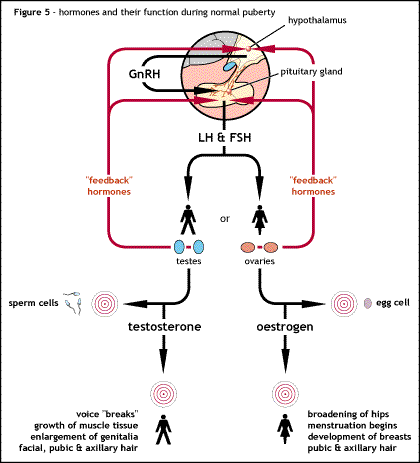
PUMPA - SMART LEARNING
எங்கள் ஆசிரியர்களுடன் 1-ஆன்-1 ஆலோசனை நேரத்தைப் பெறுங்கள். டாப்பர் ஆவதற்கு நாங்கள் பயிற்சி அளிப்போம்
Book Free DemoThe reproductive system governs the continual of the species. Reproduction is a process by which male gametes and female gametes unite together to form an embryo. This process requires many of the hormones in action. These hormones are secreted by the sex glands called Gonads.
Gonads
Gonads are formed from the embryo's mesoderm. The gonads are the sex glands, i.e. the testis and the ovaries. They not only generate sperm and ova, but they also secrete hormones.

Female and male reproductive system
Testis
Location:
Males have a pair of testis in their scrotal sac (outside abdomen). The testis is a major sex organ that also works as an endocrine gland.

Male gonad - Testis
Composition, cells and hormones present in the testis:
- Seminiferous tubules and stromal or interstitial tissue make up the testis.
- Interstitial cells, also known as Leydig's cells, are found in the intertubular spaces and produce androgens, mainly testosterone.
- Androgens control the growth, maturation, and functioning of male accessory sex organs such as the epididymis, vas deferens, seminal vesicles, prostate gland, and urethra.
Functions:
- These hormones promote muscle growth, face and axillary hair growth, aggression, low voice tone etc.
- Androgens are essential stimulants in the spermatogenesis process.
- They influence male sexual behaviour by acting on the central nervous system.
The video explaining the production of testosterone
Ovary
Location: The ovaries are found in the pelvic cavity, adjacent to the oviducts and the uterus in females.
Female gonad - Ovary
Composition and locality of hormones secretion in the ovary:
- During each menstrual cycle, the ovary is the primary female sex organ, producing one ovum.
- In addition, the ovary generates oestrogen and progesterone, which are steroid hormones. Ovarian follicles and stromal tissues make up the ovary.
- The oestrogen is mainly secreted by the developing ovarian follicles.
- After ovulation, the ruptured follicle is converted to a corpus luteum, which secretes mainly progesterone.
The video explaining the structure, hormones secretion and functions of ovaries.
The following are the hormones generated by the ovaries.
Estrogens
The cells of Graafian (ovarian) follicles release estrogens. Estrogens promote the development of female secondary sex organs, the development of ovarian follicles, the appearance of female secondary sex traits, and the development of the mammary gland. It also regulates the sexual behaviour of women.
Important!
The main feminising estrogen is estradiol.
Progesterone
The hormone Progesterone is secreted by the corpus luteum of the ovary, as previously stated. It stimulates the uterine epithelium and mammary glands to develop further. It is also necessary for the development of the placenta and the maintenance of pregnancy.
Important!
Ovulation requires both estradiol and progesterone.
Relaxin
The corpus luteum secretes relaxin only in the later stages of pregnancy, and it aids in the softening of ligaments, particularly those that hold the pubic symphysis together. Inhibin/Actin
The corpus luteum secretes inhibin/actin. FSH and GnRH synthesis is inhibited by inhibin hormone and activated by actin hormone.
Hormones and functions during normal puberty
Reference:
https://upload.wikimedia.org/wikipedia/commons/3/31/Flow_diagram_showing_normal_hormonal_control_of_puberty.gif
https://upload.wikimedia.org/wikipedia/commons/c/ca/Female_genital_system_-_Front_view_1.svg
https://upload.wikimedia.org/wikipedia/commons/c/cf/Male_genital_system_-_Front_view.svg
https://upload.wikimedia.org/wikipedia/commons/3/32/Anatomy_of_the_ovaries.jpg
https://upload.wikimedia.org/wikipedia/commons/5/55/Figure_28_01_03.JPG
https://upload.wikimedia.org/wikipedia/commons/c/cf/Male_genital_system_-_Front_view.svg
https://upload.wikimedia.org/wikipedia/commons/3/32/Anatomy_of_the_ovaries.jpg
https://upload.wikimedia.org/wikipedia/commons/5/55/Figure_28_01_03.JPG